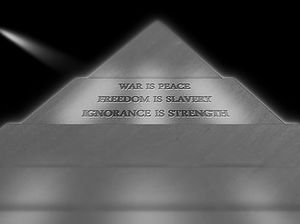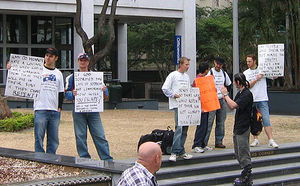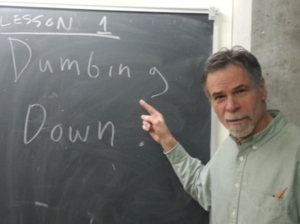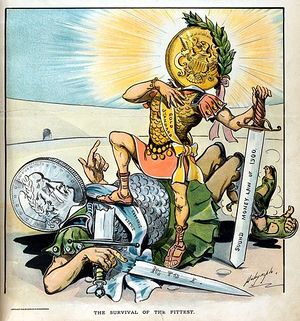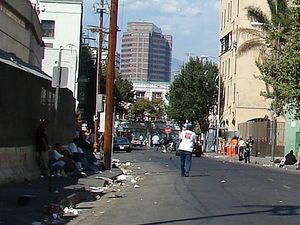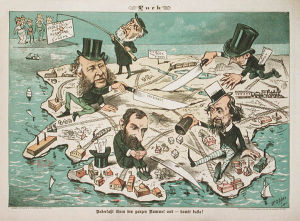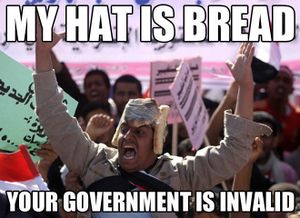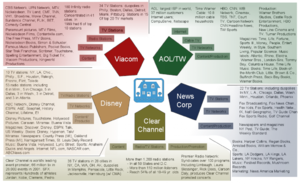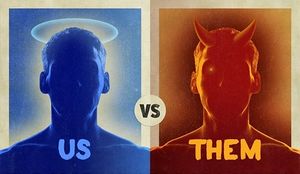Anti Patterns on one page
Preamble to Anti Pattern Project
The purpose of this exploratory project is to collaboratively explore how inequality, injustice, oppression, and other unhealthy social forces are created and maintained in society. We are cautiously optimistic that this type of analysis could ultimately prove useful in working against those inhuman social forces.
This is a wiki-based project and we do not consider it a finished piece. It's definitely a work in progress.
This is the product of the Social Imagination and Civic Intelligence program, spring 2013 at The Evergreen State College.
Introduction to the Patterns
Fundamental Evils. The first category contains the three patterns that we believe are fundamental to unwholesome behaviors.
Cultural Ignorance. The second category contains patterns that we believe describe culturally produced ignorance.
Societal Philosophy. The third category contains the patterns that we believe represent societal philosophy.
Institutionalization of Negative Philosophy. The fourth category contains the patterns that we believe institutionalize negative philosophies.
Tactics. The fifth category contains the patterns that we believe describe tactics that can used by power elites (and others) to maintain negative social interactions.
Media. The sixth category contains the patterns that we believe characterize the negative roles that the media can play.
Results. The seventh category contains the patterns that we believe represent the results or byproducts of civic ignorance. Note that each of these is also a pattern in that these tend to act as ongoing social determinants.
Fundamental Evils
The first category contains the three patterns that we believe are fundamental to unwholesome behaviors.
Civic Ignorance
Description
We place civic ignorance at the top of our anti-patterns collection because civic ignorance is at the core of everything that human beings do to each other that is harmful.
Civic ignorance takes different forms; it is their sum total and the perfidious interaction among the various forms that creates the Agnosphere, the ubiquitous shroud that fights civic intelligence on all fronts.
It is often quite “natural” and occurs in all of us to some degree. It is most menacing in its professional varieties, when well-resourced and self-serving elites intentionally cultivate ignorance. Historically, in the United States, the tobacco companies were the most treacherous and whose campaigns can be credited with thousands if not millions of unnecessary deaths. Currently the climate change denial campaign is the most prominent and much of the intentionally spread misinformation can be traced back to a handful of dedicated billionaires.
How it Works
Civic ignorance is assured in many ways — in general, that's what we're trying to show with our project. Fixating on certain hard-and-fast "truisms" is important. Blaming the other person is important. On an individual level, not even listening to a argument that runs counter to your own is effective since that avoids any real consideration of the issue. From an institutional level, access to information and communication should be controlled by elites. The items on the public agenda should be restricted — but it should not seem like this is the case. Finally, critics of the system should be marginalized or ignored.
Evidence
Links
All of the anti-patterns are related to this!
References
Agnotology book
Violence
Description
Much can be achieved through dominance and submission by using violence. If the subject cannot be subdued psychologically through fear, then injury can be inflicted. If injury is not enough, then the subject can ultimately be eliminated by murder. This is ultimately the underlying threat of violence.
How it Works
Possibly the oldest form of diplomacy, violence can be used to take what you want when others oppose you. Violence can involve only one person or very very large groups of people. Even the threat of violence can be very persuasive (see The Cold War).
Creating a culture of violence can also be used for indirectly influencing the populace. When plagued with their own mental health issues and the mental health issues of the people close to them, people may be more likely not to be concerned with what the politics of the ruling class. Violence and the threat of violent increases fear and thus decreases the possibility of solving problems intelligently. If one can manipulate people through fear you can lead them into doing things they might otherwise not want to do.
Violence is often celebrated in some cultural traditions. You can often find it's celebration in sporting events, music, movies, books, and video games. The population may be desensitized to violence through eposure to violence through the media, perhaps. People can be steered toward the use of violence too where it is portrayed culturally as the most convenient and efficient means of solving problems. This desensitization to violence eventually makes it universally accepted by the populace. It has been, for example, that heavy users of violent video games are more likely to see violence as a "solution" to social problems and are more likely to ascribe negative motives to people than the average. When violence becomes the norm, it can be used overtly by the ruling class as a means of control. The glorification of domination through violent means can also be used to gain support for war.
Evidence
349 soldiers committed suicide in 2012, while 301 died in active combat. This was the third time in four years that suicide surpassed combat deaths among American soldiers. It is assumed though not verified through scientific study that the reasons for suicide are linked to the psychological effects of combat service. The 90 percent increase in violent sex crimes committed by active U.S. Army soldiers between 2006 and 2011 is also attributed in part to the trauma of war. Soldiers suffering post-traumatic stress, traumatic brain injury, and depression have also been shown to have higher incidences of partner abuse.
A study conducted in Lebanon revealed that civilians exposed to (armed) conflict where six times more likely to have an anxiety disorder, three times as likely to have a mood disorder, and 13 times as likely to have an impulse-control disorder as people who had not experienced such events. Less than half of the survey respondents who reported a disorder had sought any treatment - and they took an average of six years to do so. (PLoS Medicine).
Linked patterns
Eye for an Eye – Retribution uses the principles of violence toward justice.
Fear Mongering uses the threat of violence.
Xenophobia often uses violence against those different cultures who are different.
Racism, like Xenophobia, often includes violence against different races or cultures.
References
PLoS Medicine, DOI: 10.1371/journal.pmed.0050061
Environmental Degradation
Description
The natural environment; including but not limited to soil, water, air, flora, and fauna, has a natural balance. Through pollution, over usage, and lack of stewardship, the balance is broken causing the natural networks that sustain life on this planet to suffer.
How it Works
Is humanity part of the environment or are we separate from it? The belief that the natural environment is something to be used and conquered is core to this pattern. This sort of Humanity Vs. Nature situation has led to the degradation of the delicate balance of natural systems that cannot be easily replenished. With a growing population the need for natural resources are rising, but in 1st world countries the amount of resources a single person can consume significantly outweighs the amount of resources a person living in the third world would.
However, this is only part of a larger problem.
When the depletion of resources cannot be replenished naturally we found ways to put a Band-Aid on the solution here and there. This has led to all sorts of problems including introducing chemical pesticides and fertilizers that allow us to create more food resources in the environment than can occur naturally. In the end, some of these end up further degrading the environment which leads to more Band-Aids.
As long as humanity-at-large sees itself as separate from the natural environment this degradation will likely continue.
Evidence
“Conservation is getting nowhere because it is incompatible with our Abrahamic concept of land. We abuse land because we regard it as a commodity belonging to us. When we see land as a community to which we belong, we may begin to use it with love and respect.”
- Aldo Leopold
A study from the University of Oregon found that in certain zones, areas that were clear cut had nearly three times the amount of erosion due to slides. When the roads required by the clearcutting were factored in, the increase in slide activity appeared to be about 5 times greater compared to nearby forested areas. The roads built for clearcutting interrupt normal surface drainage because the roads are not as permeable as the normal ground cover. The roads also change subsurface water movement due to the redistribution of soil and rock.
Links
Consumerism is a major cause of Environmental Degradation, especially with it's "throw away" cultural values.
Denialism helps to perpetuate the continuation of Environmental Degradation in that people can be in denial of the problems we create for the environment.
Silenced Voices helps this pattern by silencing the voices of those who speak out against or warn others about this patterns existence.
Conservation Reliance happens as a result of this pattern when the ecosystem that supports certain species degrades to the point that it can no longer support them.
References
Swanson, F.J.; Dyrness, C.T. (1975). "Impact of clear-cutting and road construction on soil erosion by landslides in the western Cascade Range, Oregon". Geology (Geological Society of America) 3 (7): 393–396. http://www.wisegeek.com/what-is-environmental-degradation.htm
Cultural Ignorance
The second category contains patterns that we believe describe culturally produced ignorance.
Consumerism
Description
Consumerism is a cultural system that is predominantly based on the acquisition and display of material goods. Although consumerism is enacted individually by people who are seemingly driven internally to buy consumer goods (never staples), the drive can probably be traced to a media-induced need production which convincingly defines what the “good life” and how it can be purchased. It also sets up the standards of status through which people can be judged and these are in turn taken up by peer groups who help maintain the system. [1]
How it Works
In order for consumerism to work in any society people need to have disposable income (money left over once basic needs like food, water, and shelter are met). It helps if the members of this society believe that their consumerism is good for the society at large, for example: after World War 2 American citizens were encouraged to buy new products to help the economy recover after the war and the great depression [2].
A large middle class, with disposable income, and not much to worry about, is also very beneficial to creating a culture of consumerism. Consumerism also thrives when people spend a large portion of their time doing things other than work. The 40 hour work week, having several full days off a week, and having the ability to take extra time off from work, all help consumerism to thrive.
Evidence
Links
Environmental Degradation is linked to this pattern in that consumerism is a major cause of Environmental Degradation in that it uses vast amounts of environmental resources and creates vast amounts of waste for the environment.
Compartmentalization of Knowledge works with consumerism in that many people really do not have access to the knowledge of what the effects of consumerism actually are, like the waste created or non-renewable resources used.
Denialism: Consumerism relies on denialism to function when people do know the negative effects of consumerism but chose to be in denial about these effects anyway.
Activism Delegitimization works with perpetuating consumerism in that attempts are often made to delegitimize the activists who speak out against consumerism, such as the "Hippie" Movement of the 60's and 70's (In the USA).
Affluenza is a term used to describe a kind of chronic consumerism. It could be said that it is consumerism taken to its natural conclusion.
References
http://www.encyclopedia.com/topic/Consumerism.aspx
- ↑ Miles, Steven. "Consumerism: as a way of life." (1998).
- ↑ Consumption and Consumerism: http://www.globalissues.org/issue/235/consumption-and-consumerism
Semantic Manipulation
Description
Certain words, phrases, or ideas become taboo in societies due to their negative definitions. When these definitions prevent governments or corporations from their goals, they will sidestep the problem by redefining/rephrasing words or using straw man tactics to manipulate the public into accepting something they otherwise would not accept. Redefining negative or positive words, phrases, or ideas to change their meaning to support an argument or idea. This is done without changing the true merits of the words or phrases.
How it Works
To rename or relabel an act or object for the purpose of acquiring different results, outcomes or perspectives can be classified as Semantic Manipulation. The distortion of the original semantics can be motivated by wealth, power or to maintain the status quo within an organization that is reluctant to change. Like wise, Semantic Manipulation can be used to provide you with false information within media and especially pseudoscience. in doing so,Semantic Manipulation can not only be used to maintain a certain course within a system, but can also be used to influence it into a different direction. This works because language can be used to influence people's actions and beliefs. As linguist Benjamin Whorf stated, "“The structure of anyone’s native language strongly influences or fully determines the world-view he will acquire as he learns the language.”[1]
Evidence
There have been many different examples in the last few years in explaining how Semantic Manipulation works. One of the most disasterous examples is that of the Bush administration distorting the fact that lead up to the Gulf War. Despite the fact that the UN weapon inspectors could not find evidence of weapons of mass destruction in Iraq. The Bush administration created their own fact to support their agenda within the Middle East. [2]
The Semantic Manipulation of the fact of Iraq's weapon program, coupled with the idea that Iraq had something to do with the 9/11 attack was the reason the U.S. went to war in the Gulf. Against the backdrop of protest within and outside the U.S. against the war, and conflicting information coming to light against the Bush administration original claim, The U.S. entered open hostilities with Iraq under false and distorted information. The willful manipulation of data to support a preconceived agenda is almost always at the core of Semantic Manipulation.
During the W. Bush administration semantic manipulation was everywhere. “The War on Terrorism” was a semantic manipulation of the word “terrorism,” which is loosely defined, however it gave the government the extra power it has in time of war for an indeterminable amount of time. The Patriot Act, the invasive, controversial legislation was given a name that suggests anyone against it was “unpatriotic.” The slogan “Support the Troops” was seen everywhere, suggesting that if one was against the indefinable, unjust war that they were also against the troops. This again suggests opposers were “unpatriotic.” The best example may be that torture was renamed “enhanced interrogation.”[3]
Private companies can interpret words present in laws to try to manipulate the outcome of certain legal matters. [4]
Links
Professional Obfuscation and Semantic Manipulation are very closely related and are used for much the same purpose as the other. They are often used interchangeably and side-by-side.
Distorting History: Semantic Manipulation is a sort of history distortion in that you are changing the meanings of established words and phrases that have historically been used for other meanings.
Hidden Agendas works with this pattern in that Semantic Manipulation often distorts the agenda being propagated thru the method of changing the way we talk about it.
References
- ↑ Brown, R. (1976). Reference in memorial tribute to Eric Lenneberg. Cognition, 4(2), 125-153.
- ↑ Freedman, Lawrence. "War in Iraq: selling the threat." Survival 46.2 (2004): 7-49.
- ↑ Nordgren, Loran F., Mary-Hunter Morris McDonnell, and George Loewenstein. "What constitutes torture? Psychological impediments to an objective evaluation of enhanced interrogation tactics." Psychological science 22.5 (2011): 689-694.
- ↑ http://truth-out.org/news/item/16167-retail-exemption-shields-some-fertilizer-facilities-from-stringent-safety-requirements
Fundamentalism
Description
Fundamentalism is a catch-all term for a broad family of rigid and extreme beliefs. No country is immune: fundamentalism is found all over the world and although there are endless varieties, these various versions show remarkable similar characteristics. Among these characteristics are strong patriarchies, strict exclusionism, strict adherence to certain doctrines and writings, an acceptance of violence, xenophobia, and belief in the end of the world.[1]
How it Works
Interestingly, the idea of fundamentalism is a relatively recent invention. Scholars assert that it is a broad response to modernism and it is often helped along when secular governments fail. Fundamentalism is often linked with extreme aversion to social and cultural change[2]. It could also be said that Fundamentalism is defined by unwillingness to change and a strong desire to impose a certain set of beliefs and ideals above others. In order for fundamentalism to exist there needs to be some change that threatens the ideals and beliefs of a group of people. Examples would include the debate over separation of church and state by Christian Fundamentalists in the United States, or even some acts of terrorism carried out by Islamic fundamentalists against consumeristic “western” societies.
Fundamentalism is often an attempt to further the views of one group of people over another group of people and as such it can often result in outbreaks of violence, human rights violations, and even genocide.
Evidence
Links
Ultra-nationalism: Both Fundamentalism and Ultra-nationalism involve a strict adherence to a set of specific beliefs. In this comparison the main difference between the two is that Fundamentalism relates to a set of religious beliefs and Ultra-Nationalism relates to a set if political beliefs.
Xenophobia: It could be said that Fundamentalism can (often) involve targeting differing groups of people with beliefs that differ from your own. This could stem from fear of the group of people themselves or fear of what their beliefs represent, but either way it does relate to Xenophobia.
Violence: Some Fundamentalist groups have been known to use violence as a means to further their agendas. This is not to say that all groups use this tactic, but it is often part of the cultural view on fundamentalist groups that action thru violence is often used. This is what is known as religious violence.
References
- ↑ Woodberry, Robert D., and Christian S. Smith. "Fundamentalism et al: Conservative protestants in America." Annual Review of Sociology (1998): 25-56.
- ↑ http://www.huffingtonpost.com/sean-mcelwee/christian-fundamentalists_b_3708416.html
Marty, M. and Appleby, S. (1991) Fundamentalisms Observed. Chicago: Chicago University Press.
Compartmentalization of Knowledge
Description
Knowledge is effectively compartmentalized (or put into "compartments") when different people not only have access to certain types of knowledge but are actually denied formally or via social norms or personal preferences from going beyond their allowable sphere.[1]
Compartmentalizing knowledge has several effects. For one thing it prevents people from having a holistic view. (And since many of the phenomena that now exist can only be "understood" when several viewpoints and perspectives from various sets of knowledge.) Also, as in the Tower of Babel story in the Bible, it keeps people from different knowledge camps from communicating with each other. Finally it implicitly designates certain types of knowledge as "off limits" to some people, thus locking them out of any conversations which employed or built on the knowledge that was forbidden to them.
How it Works
Compartmentalizing knowledge takes different shapes in different times and places. One of the more obvious examples are academic departments in colleges or universities.
Evidence
Links
Denialism: When people don't have access to, or don't trust, the knowlege out there it becomes easier to be practice Denialism.
Forbidden Knowledge: Forbidden Knowledge is sort of the industrial sized version of Compartmentilization fo Knowledge.
Consumerism: The Consumerism pattern works with the Compartmentalization of Knowledge Pattern because when people don't have a holistic view of consumerism they are likely to not care as much about the side effects of consumerism.
References
http://en.wikipedia.org/wiki/Compartmentalization_(intelligence)
- ↑ Mergel, Ines. "The use of social media to dissolve knowledge silos in government." The future of public administration, public management, and public service around the world (2011).
Distorting History
Description
Altering history by teaching manipulated stories, facts, and data is a means of promoting specific ideologies and agendas. This can be achieved by creating events that did not happen, altering events that did happen, or omitting events altogether. Over time, knowledge of the truth will die with those who lived or witnessed it, and the alternate version will be universally accepted as true.
How it Works
Distorting history is an effective method of erasing events from the minds of the population, of glorifying events and people in support of state ideals, and vilifying events and people in conflict with state ideals. Presenting history in a way that supports the agenda of the state, and reinforcing it through the public education system and the media can be used to control the perceptions of the populace in ways that prevent dissent and promote nationalism.
Evidence
Early American history as taught in the public school system contains many examples of myths and exaggerated heroism[1]. Many elementary and high school school textbooks, including modern textbooks, contain misinformation and stereotypes that generalize American Indians as primitive and as savages[2].In these same text books little is said about the native population plummeting by an estimated 80% between 1492-1650 due to disease carried from the Old World settlers, outright massacres, and forced labor[3].
Language that stereotypes and distorts history against the American indian is even written into the American Declaration of Independence where one paragraph charges the king of england with the following:
"He has excited domestic insurrections amongst as, and has endeavoured to bring on the inhabitants of our frontiers, the merciless Indian Savages, whose known rule of warfare is an undistinguished destruction of all ages, sexes and conditions."[4]
The Vietnam War seems to barely be mentioned in public school history lessons. Most Americans have a perception of it being unpopular, and even bad, but have no knowledge of the war crimes committed by Americans, and the extent to which even soldiers protested the war(Citation Needed).
Links
Semantic Manipulation: Semantic Manipulation is a kind of distortion of words and this is a kind of distortion of history as well. Also when we change the past meaning of words we lose touch with historical meanings of those same words.
Denialism: One of the ways to distort history is to deny that certain events happened the way that history tells us they didn't, or to deny that they happened at all.
Cultural imperialism:The famous quote, "History is written by the victors," may be widely disputed by historians, but history is certainly skewed toward dominant cultures that successfully practice Cultural Imperialism.
Ultra-nationalism:At the core of ultra-nationalism is the need to rewrite any history that does not agree with our view of our nation being a just and deserving nation that is a force for good in the world... or something to this effect.
Dumbing Down:Sometimes history is complicated and not black and white but mixed with varying shades of gray, blue, and... fuchsia? Whatever the exact mix of colors, this can sometimes make the past a complicated and morally ambiguous mess. This mess can be “fixed” (Dumbed Down) by taking out the questionable bits and repackaging them to fit some agenda; even if that agenda is just to feel like the world is an understandable place where villains are always beaten by unicorns riding rainbows of justice. You get the idea.
Xenophobia: History distortion can have a lot to do with distorting different cultures to make them seem less sympathetic and more evil and bad. So you look better; because you aren’t them.
Resources
http://en.wikipedia.org/wiki/Dunning_School#Criticism_of_the_Dunning_School_.281950-2007.29
http://en.wikipedia.org/wiki/Holocaust_denial
- ↑ Loewen, James W. Lies my teacher told me: Everything your American history textbook got wrong. The New Press, 2008.
- ↑ Garcia, Jesus. "From Bloody Savages to Heroic Chiefs." American Indian Education 17.2 (1978): 15-9.
- ↑ Derham, Michael. "Undemocratic democracy: Venezuela and the distorting of history." Bulletin of Latin American Research 21.2 (2002): 270-289.
- ↑ Zinn, Howard. "Tyranny is Tyranny." A people's history of the United States: 1492-2001. New ed. New York, NY: HarperCollins, 2010. 56-76. Print.
Dumbing Down
Description
The term Dumbing Down started in 1933 when motion picture screenplay writers changed the way they wrote in order to gain appeal with those of who had little education or intelligence. However, Dumbing Down will usually involve simplifying critical thought to a point where it begins to undermine intellectual standards of learning in a society. This then trivializes cultural, artistic, and academic standards.
How it Works
Dumbing Down has been frequently used in the workplace in the last century, often by the name, “de-skilling.”[1] De-skilling involves reducing responsibility and skills needed for the employee to perform their work tasks. This is considered by some to increase efficiency, profits, and management control. The assembly line model of manufacturing, where every employee only does one repetitive task, over and over, is an example of this kind of pattern used in the workplace. Critics state that this kind of model reduces the employee’s autonomy, flexibility, and often results in lower workplace moral.[2] This pattern can also be used in the social sphere where critical thinking can be discouraged. Some scholars suggest that media encourages dumbing down by focusing on the spectacle rather than meaningful discussion, and that some principles of economics promote measuring success via monetary gain over all else having a dumbing down effect as well. [3]
Evidence
In the late 20th century, the increased number of students attending university, because of lowered scholastic aptitude standards, required the establishment and maintenance of intellectual distinctions; thus, in 2003, the UK Minister for Universities, Margaret Hodge, criticized Mickey Mouse degrees as a negative consequence of universities dumbing down curricula to meet “the needs of the market”, degrees conferred for studies in a field of endeavor "where the content is perhaps not as [intellectually] rigorous as one would expect, and where the degree, itself, may not have huge relevance in the labour market", thus, a university degree of slight intellectual substance, which the student earned by "simply stacking up numbers on Mickey Mouse courses, is not acceptable"[4][5]
Strict standardized testing methods prize quantitative skills rather than qualitative skills by promoting memorized learning rather than critical thinking. This helps to create a system that strives for mediocrity over the extraordinary.[6]
The science fiction film Idiocracy (2005) portrays the U.S. as a greatly dumbed-down society five hundred years hence; which low cultural condition was achieved with dysgenics, over-reproduction by people of low intelligence being greater than the rate of reproduction of people of high intelligence, i.e. the educated.
The novel Brave New World (1931), by Aldous Huxley, discussed the ways that society was effectively dumbed-down in order to maintain political stability and social order.
Links
Media Monopolies help by promoting spectacle over information or meaningful discussion.
History can be complicated and full of morally grey areas that promote critical thinking and subjective opinions. The Distorting History pattern can be used to simplify history to more quantifiable and less subjective facts. This also has the effect of dumbing down.
Denialism is a mechanism through which dumbing down can be promoted and assimilated—and not challenged.
Assembly Line Education is a type of education that is extremely dumbed down by promoting mediocrity and conformity over exceptionality.
Resources and References
- ↑ Braverman, H. (1998) Labor and Monopoly Capitalism, New York: Monthly Review Press.
- ↑ Schuler, Doug. "Cultivating society's civic intelligence: patterns for a new 'world brain'." Information, Communication & Society 4.2 (2001): 157-181.
- ↑ Schuler, Doug. "Cultivating society's civic intelligence: patterns for a new 'world brain'." Information, Communication & Society 4.2 (2001): 157-181.
- ↑ "'Irresponsible' Hodge under fire", BBC News, 14 January 2003. URL accessed on 24 June 2006.
- ↑ "50% higher education target doomed, says thinktank",EducationGuardian.co.uk, 14 July 2005. URL accessed on 24 June 2006.
- ↑ Kohn, Alfie. The case against standardized testing: Raising the scores, ruining the schools. Portsmouth, NH: Heinemann, 2000.
Forbidden Knowledge
Description
This is the industrial strength version of Compartmentalization of Knowledge. This occurs when knowing something is actually denied to a certain group of people under the threat of penalty. It’s worth it to mention that the Forbidden Knowledge pattern is almost always used a response to potentially damaging information against a product, organization, or group of beliefs.
How it Works
Taking a type of knowledge “off the table,” can have a variety of benefits. If you have a product that some people criticize or otherwise speak out against it may be beneficial to utilize this pattern to at least minimize some of the backlash against your product that you might receive otherwise. In the case of gun violence being denied status as a public health hazard, there are likely lobbyists for the NRA involved in petitioning government officials to forbid the CDC from calling guns a public health hazard. Having lots of money and/or power helps.
Evidence
One recent example is when the Centers for Disease Control in the US was forbidden by the US Congress to study gun violence as a "public health hazard.' According to Wikipedia, "In 2010, there were 19,392 firearm-related suicide deaths, and 11,078 firearm-related homicide deaths in the United States."(Original Citation needed-not wikipedia) In early 2013, the US Congress passed a new law that the National Science Foundation could not fund Political Science research.[1]
in 2013 Edward Snowden, a former contracted National Securty Administration employee, released classified documents to the press. The leaked documents contained details of global NSA surveillance programs.[2] The full contents of the documents is still unknown as the release of information is still ongoing. These documents revealed that the NSA routinely performs phone tapping and obtains phone records on millions of people around the world, including phone records from US citizens. Edward snowden was charged with espionage by US federal prosecutes for releasing this information,[3] showing that this is a case of forbidden knowledge.
Links
Compartmentalization of Knowledge, Opacity, Professional Obfuscation
Resources and References
See also: Photography banned from agricultural settings
http://chronicle.com/blogs/brainstorm/forbidden-knowledge/48635
- ↑ http://www.insidehighered.com/news/2013/03/21/senate-votes-defund-political-science-research-save-tuition-assistance-budget-bill
- ↑ Greenwald, Glenn and Ewen MacAskill. "Boundless Informant: the NSA's secret tool to track global surveillance data". The Guardian. Retrieved June 12, 2013.
- ↑ Finn, Peter; Horwitz, Sari (June 21, 2013). "U.S. charges Snowden with espionage". The Washington Post.
Opacity
Description
This pattern means that important information is kept secret from citizens. This is useful when hiding corruption, nepotism, money laundering, smuggling, vote buying, tax evasion, etc. When information is kept private there is less chance that malfeasance can be noticed. With Opacity in place, over the years elite business and governments can distance themselves further and further away from any controls on them.
How it works
Keeping things from the public eye can be maintained through laws or through habit. Sometimes when there are transparency laws, a government can designate things to be secret in order to maintain state security.[1] It is widely speculated that government will often classify documents for personal reasons or non-security reasons, but when the government It is interesting to note that even if there is transparency, societal apathy can mean that corruption and other crimes can continue without interruption.
Opacity prevents people from seeing how business and governments actually conduct their affairs. This encourages corruption because there is no oversight.
It can also establish this as a habit which ultimately can be seen as the "natural state of affairs", the way things are actually supposed to be.
Evidence
Freedom of information laws are routinely challenged by governments around the world. In the US, despite the Freedom of Information Act, official requests for information are routinely denied despite the information falling into categories that are permitted within the FOIA.[2]
In some cases the classified information includes the details about the the workings of a branch of government, as is the case with the Edward Snowden NSA document leaks, showing that the NSA engages in phone tapping and gathers call records from millions of people across the world. Included in this information that they listed as classified is the knowledge that the NSA keeps phone records and engages in wire tapping in the first place.[3]
Links
Corruption and Fraud, Professional Obfuscation, Forbidden Knowledge, Hidden Agendas
References
http://www.helleniccomserve.com/opacity.html
- ↑ The Conflicts Behind Government Opacity. http://www.cityethics.org/node/627, Retrieved March, 7 2014.
- ↑ Roberts, Alasdair. Blacked out: Government secrecy in the information age. Cambridge University Press, 2006.
- ↑ Greenwald, Glenn and Ewen MacAskill. "Boundless Informant: the NSA's secret tool to track global surveillance data". The Guardian. Retrieved June 12, 2013.
Hidden Agendas
Description
Society expects its leaders to keep their agendas transparent and in line with the agenda of the groups and people that they represent, however, this is rarely the case. Those in power often have agendas of their own that aren’t in line with the public’s limited expectations of them, and for this reason they may choose to keep these agendas hidden. Of all the patterns this one may be the most pervasive and potentially destructive.
How it Works
Hidden agendas work by keeping certain information secret and misrepresenting the true motives behind an action. It can sometimes use the ability to distort history to be in line with whatever agenda is being propagated. It is very important to shut down any vocal opposition or questions about the possible reality of the hidden agenda, if such an opposition arises. It often relies on the societal apathy of the people who may be affected by this hidden agenda and their ability to be distracted by other things that may demand their attention.
If the hidden agenda gets out, it can disenfranchise citizens and fuels their disrespect and distrust for those in charge. Once trust is broken, the people may begin to look for more evidence of lies and distrust can snowball. Hidden agendas cannot represent the people’s best interest if they have no say (as they've been kept in the dark) and overtime can lead to civil disobedience and social unrest.
Evidence
An example could be the motives of the 2002 US/Iraq war It was said that this war was a war on terror as officials in the US government implicated Saddam Hussein being involved in the attacks on the World Trade Center in New York City on September 11th, or 2001. These implications were questioned by skeptics and have been denounced by various groups and multiple official investigations into them, including the US select senate committee on Intelligence.[1] Top officials from both sides of the aisle later came out and indicated that the war was for the protection of oil assets, not the spread of democracy and freedom.[2]
Links
Semantic Manipulation, Distorting History, Corruption and Fraud, Opacity, Societal Apathy, Weapons of Mass Distraction, Advertising-Funded Media
References
- ↑ Mark Mazzetti and Scott Shane, "Bush Overstated Iraq Evidence, Senators Report," New York Times (6 June 2008).
- ↑ http://www.washingtonsblog.com/2013/03/top-republican-leaders-say-iraq-war-was-really-for-oil.html , retrieved Feb 2nd, 2014
(combined the following two)
Corruption and Fraud
Description
Corruption and fraud are, in this context, when an entity in power does things that are dishonest or contrary to commonly accepted ethics and laws. "Corruption and fraud both mean the misuse of public power for private gain (including gain for one’s own family, group or party)."[1]
How it Works
Profit may be involved, in the form of money or power where favors are exchanged for favors. Often these favors are not legal or questionably legal. In order for curruption and fraud to happen the party engaging in this activity has some kind of power and is abusing this power for some kind of personal gain. Representitives in government could be accepting bribes in order to back certain legislation or to vote one way or another.
evidence
A global study into corruption and fraud in the public sector found that public corruption and fraud was an issue that effected countrties from all parts of the world, although to varying degrees.
From the study: "The countries which are mentioned most often as the most corrupt countries in the world are (in this order): Italy, Russia, Nigeria, Brazil, Colombia, Mexico, China, Japan, Zaire and Indonesia."[2]
In October of 2001 news broke that the US company Enron had been lying to thier investors and falsifying thier revenue reports by reporting that they had profits beyond what was actually true. The complexities of the Enron scandal cannot really be overstated, but basically thier accountants falsified profits to make it look as if they made more money than they did, and the accounting firm that was auditing them--the people who are supposed to be safeguarding against this kind of thing--they were in on it too[3]. The scandal was basically one of accounting fraud although there were other illegal activites going on as well. The scandal eventually resulted in the bankrupcy of Enron and the jailing of several executives for the company. Former CEO's Kenneth Lay, and Jeffrey Skilling were both convicted for 29 counts, including insider trading, securities fraud, making false statements to banks and auditors, and conspiracy.[4]
The Hidden Money(citation needed)
Links
Opacity, Hidden Agendas, Profit-motivated Health Care,Societal Apathy
References
List of federal political scandals in the US: http://en.wikipedia.org/wiki/List_of_federal_political_scandals_in_the_United_States
List of state and local political scandals in the US: http://en.wikipedia.org/wiki/List_of_state_and_local_political_scandals_in_the_United_States
- ↑ Huberts, L. W. J. C. "What can be done against public corruption and fraud: Expert views on strategies to protect public integrity." Crime, Law and Social Change 29.2-3 (1998): 209-224.
- ↑ Huberts, L. W. J. C. "What can be done against public corruption and fraud: Expert views on strategies to protect public integrity." Crime, Law and Social Change 29.2-3 (1998): 210.
- ↑ Petrick, Joseph A., and Robert F. Scherer. "The Enron scandal and the neglect of management integrity capacity." American Journal of Business 18.1 (2003): 37-50.
- ↑ Johnson, Carrie (2006-10-24). "Skilling Gets 24 Years for Fraud at Enron". Washington Post.
Societal Philosophy
The third category contains the patterns that we believe represent societal philosophy.
(patterns that are used to "justify" or rationalize consciously or unconsciously other behavior?)
Social Darwinism
Description
The principles of evolution dictate that those with beneficial mutations are more likely to survive while those with non-beneficial mutations will fail. Likewise there are sometimes non-beneficial traits that people possess that make them more likely to "fail." These things can be genetic or developed elsewhere. Things like health issues, chronic conditions, disabilities, etc. The idea of Social Darwinism in it's most extreme is that it is natural that these people fail, and that society shouldn't feel responsible for taking care of them. Basically, it's a dog eat dog world.
How it works
While some people might have arguments about whether or not we can save money on health care by giving the government more control in regulating costs vs offering incentives for organizations that self regulate Social Darwinist's know the best way to save money on health care is to not pay for it in the first place! It turns out you can save tons of money by adopting Social Darwinism. Balancing the government's budget will never be easier... in fact why have a governmental budget at all? People should take care of themselves, right?
Evidence
A study at Harvard found that having a high propensity for social dominance made people less tolerant of others, less likely to help those less fortunate than you, and more politically conservative. They also found that they are more likely to believe that a higher power will take care of people who need taken care of.[1]These things could correlate with ideas of social darwinism.
Links
Violence, Eye for an Eye – Retribution, Silenced Voices, Monopoly
References
http://library.thinkquest.org/C004367/eh4.shtml
- ↑ Pratto, Felicia, et al. "Social dominance orientation: A personality variable predicting social and political attitudes." Journal of personality and social psychology 67.4 (1994): 741.
Denialism
Description
This is the adherence to certain beliefs proven to be untrue or refusing to accept as truth something that has been proven to be true. sometimes supported by certain media outlets and pseudo-sciences. Often motivated by religious beliefs, self-interest, or as a defense mechanism out of fear or discomfort.
How It Works
Relieves guilt by taking away responsibility.
Can be used to postpone or eradicate fixing problems that the state doesn't want fixed.
Though proof is presented, individuals continue to deny the proof and adhere to their false beliefs.
Problems can be reframed in a way that they are represented as not being problems at all. Popular beliefs can be played upon to invoke denial of the problem.
Evidence
Denialism is not just an American problem but a global one as well. The rearrangement of facts or events to support ideas that certain thing never happened or at least they are watered down to the point that they cease to be irrelevant. With the American story this can be best illustrated in the events leading up to the civil war. Modern revisionist historian claim that the war was not about slavery, but state’s rights instead. A quick check of South Carolina’s or Georgia’s declaration of secession will dispel that notion. The denialism of this fact is self-evident; this is a desire to clean up the image for which the south was fighting for by forgetting the reason for the conflict in the first place, the preservation of slavery. On the global scale there is the holocaust denialism; that Nazi Germany did not engage in state sponsored extermination of a race of people. Climate change denialism; that the Earth has not been affected by man’s industrialization of the planet. These are just a few examples of how this anti-pattern/
Linked Patterns
Weapons of Mass Distraction, Dumbing Down, Compartmentalization of Knowledge, Distorting History, Societal Apathy, Media Monopolies, Professional Obfuscation.
Resources
http://www.guardian.co.uk/environment/2013/feb/14/funding-climate-change-denial-thinktanks-network
http://www.pacinst.org/wp-content/uploads/2013/02/climate_statement3.pdf
Eye for an Eye – Retribution
Description of the pattern
Equivalent exchange by way of exact behavior. There is no need to "be the better person" because you will be the only one. This is the idea that, "doing unto others the same as has been done unto you," is the true balance of justice.
This pattern upholds the running behavior that seems to underline a lot of society. The idea of "Returning the Favor" has evolved and resides in the shadows along with most hidden agendas (see hidden agendas). By keeping a "laser pointer" on the simplicity of what it is in any form, eye for an eye can never truly loose it's muster. It is "instant gratification" the current moment- which is important when there is a demand for quick respond.
How it Works
Eye for an Eye is, in it's purest form, doing exactly what is done to other party that has been done to them. Example: to kill another is to be punished by death. As time as passes, the way in which it may manifest can vary. This is due to the complexities of society. The idea dates back to biblical times- See Matthew 5:38 (King James Version).
Evidence
Mutually assured destruction: I.e. Policies on nuclear warfare, Hatfield and McCoy Feud that lasted (1862-1891)
Linked patterns
References
Cultural imperialism
Description of the pattern
This pattern presents the way in which powerful cultures present their culture as the most acceptable lifestyle, and condemn the cultural practices of others. This often take place in tandem with the more official imperialism. Many nuances of culture are exotic and acceptable, but if it contradicts the values of the dominant culture, the ideals of the more vulnerable must be eliminated.
How it Works
Disagreements in cultural values can cause tension, especially for a dominant culture, therefore the dominant culture must eliminate the other in order to maintain peace. The systems of capitalistic enterprise requires a common culture in order to produce and sell products to the consumer in the most efficient and profitable manner. The more people agree and think alike the easier it is to direct advertising and trend towards the consumer.
Evidence
The greatest example is the conceptualization of "The American Dream". This ideology has been presented to countries around the world as the greatest system of cultural ideology, and continue to present the values of one country as better than any other. The expansion of american consumerism is among the strongest cultural aspects that has been presented and implemented in other cultures, often to their detriment. Within the united states itself, cultures that do not represent american cultures are viewed as a threat and are often stigmatized.
Links
Consumerism, Monopoly, Xenophobia
References
http://www.americanforeignrelations.com/A-D/Cultural-Imperialism-Critics-of-cultural-imperialism-theory.html http://www.wordiq.com/definition/Cultural_imperialism http://www.princeton.edu/~achaney/tmve/wiki100k/docs/Cultural_imperialism.html
Ultra-nationalism
Description
This is the belief that your country of choice is bar none, hands down, the best country in the world. No other country comes close and your countries interests are more important that all other countries interests...combined. When an individual (or nation) has this type of hold on the people, things run smooth- there is also very little questioning.
This could include the act of using nationalism to rally and sway the perceptions one's country (or group of people) by designating an enemy. This is typically a diversionary tactic in order to take away unwanted attention and or to win popularity. This method aids in creating tunnel vision as well as granting a sense of solidarity to those involved.
How it works
Endless promotion and advertising should be invoved to make it clear that it is honerable and desireable to belive in your country above all others. If your subjects are religous It should be insinuated or outright stated that thier God has somehow blessed the country and gave it to it's people. If you can make people believe that your particular country is endorsed by the divine this is very powerful. People want to belong and be accepted. People also want to be on the right side of things and believe that they deserve better. These basic human needs and desires make ultra-nationalism work, as it can be used to maek people see themselves as part of a country.
Evidence
9/11's events has created one of the biggest examples of Ultra-nationalism in history thus far. The PATRIOT act came into full affect shortly after- something that the American society, otherwise, would have said no to- a direct result of Ultra-nationalism.
Links
Denialism,Cultural imperialism
References
The Patriot Act http://www.washingtonspectator.org/index.php/ultra-nationalism.html
Institutionalization of Negative Philosophy
The fourth category contains the patterns that we believe institutionalize negative philosophies.
Criminalizing Poverty
Description
Poverty can be criminalized, both ideologically and physically in various ways in order to keep people in the cycle of poverty.
How it Works
Poverty is among the greatest threats to the structure and ideology of capitalistic culture. If poverty is viewed as being a failure of the system, the power structure may be in danger. Therefore, if the poverty stricken are classified as criminals, they are personally responsible for their state, and the power structure is not in danger.
Poverty is often criminalized in ways that are hidden to the public and not overtly "anti-poverty" on the surface. Legislators in some states have passed bills that force people who are applying for unemployment benefits to be drug tested and fingerprinted—creating a culture in which the unemployed are to be treated as criminals.[1] In many cities across the US cities are adopting anti-loitering laws which are often viewed as anti-homeless laws and anti-poverty laws. In many cities there are laws stating that people may not sleep on benches or other public areas, cannot sit down on the sidewalk, next to buildings, or on the ground. In San Francisco, laws against urinating or deficating in parks or other public areas are, "...being enforced with a new-found rigor even as the city repeatedly refuses to install public toilets."[2]
Evidence
Cities, such as Los Angeles, have decided to implement policies to pump money into the police force and arrests for low level crimes with the idea that this will catch high level crimes as well. In the case of Los Angeles in 2005-2006 the city initiated a "Safer Cities Initiative" which was supposed to be a comprehensive plan to deal with the homelessness issue in the Skid Row area of LA. This was reportedly going to consist of comprehensive services including housing, mental health services, etc. Instead the city spent six million dollars in beefing up thier police service and zero dollars on other services.[3]
"In recent years, the United States has seen the proliferation of local measures to criminalize “acts of living” laws that prohibit sleeping, eating, sitting, or panhandling in public spaces. City, town, and county officials are turning to criminalization measures in an effort to broadcast a zero-tolerance approach to street homelessness and to temporarily reduce the visibility of homelessness in their communities. Although individuals experiencing homelessness should be afforded the same dignity, compassion, and support provided to others, criminalization policies further marginalize men and women who are experiencing homelessness, fuel inflammatory attitudes, and may even unduly restrict constitutionally protected liberties. Moreover, there is ample evidence that alternatives to criminalization policies can adequately balance the needs of all parties. Community residents, government agencies, businesses, and men and women who are experiencing homelessness are better served by solutions that do not marginalize people experiencing homelessness, but rather strike at the core factors contributing to homelessness."[4]
Links
Denialism,Dehumanization, social Darwinism
Resources
- ↑ Sasha Abramsky. The American Way of Poverty: How the Other Half Still Lives. Nation Books, 2013. Pg. 178-179.
- ↑ Mitchell, Don. "The annihilation of space by law: the roots and implications of anti‐homeless laws in the United States." Antipode 29.3 (1997): 303-335. Pg. 305.
- ↑ Napper, T. (Director). (2013). Lost angels - skid row is my home [Documentary]. USA: Cinema Libre Studio.
- ↑ "Executive Summary." Searching out solutions: constructive alternatives to the criminalization of homelessness.. Washington, DC: United States Interagency Council on Homelessness, 2012. 2. Print.
Assembly Line Education
Description
A “Conveyor Belt” type system of education that does not provoke thought, engage students, or encourage achievement. An assembly line educational system is one in which a school is viewed in the likeness of a factory. Children are placed on a "conveyor belt" and sent down the line to be assembled accordingly (regardless of whether or not their mind functions in the same likeness of the majority.) This system works against the natural processes of the human mind.
How It Works
The “Conveyor Belt” system does not account for children with special needs, is unsympathetic to home life, uses student activities that promote ultra-nationalism and competition, and uses poor methods of teaching that dumbs students down.Students with special needs (ranging from a mild learning disability to down’s syndrome) are lumped together in one classroom with differing needs that are not all met and so they remain stagnant. Many teachers have students that they are unable and unequipped with knowledge to understand due to their home life. This is another aspect of special needs that are being unmet due to teachers’ misunderstanding and misinformation. Pep rallies and rivalries with other schools are a sort of preparation for nationalism but can easily be turned into blind pride and blind following. The competitiveness also takes away from the sense of community. Finally, this method of schooling reinforces the dumbing down of Americans by discouraging critical thought while encouraging submission.
This method of educating students was effective over fifty years ago, but our world has transformed and the traditional education system has become outdated. Students are forced to go to the schools based on their location and are placed on a track based on their test scores. If they score low, they go to a lower ranking school with lower expectations and vice versa. When students are expected to fail or succeed, it is likely that they will do just that due to self-fulfilling prophecy. Children living in low income areas attend schools with environments that they likely don’t feel safe in and that their teachers expect little of them.
Because of Teacher Unions, teachers working at a public school for two years are able to receive tenure if they meet the necessary requirements. After tenure, it is nearly impossible to fire these teachers.
For most students, dropping out of school leads to prison or death. In “Waiting For Superman” (link posted below) it is stated that it costs $123,0000 for just four years in prison while it is only $8,300 for thirteen years of private schooling. Even with this knowledge, it is unlikely that our systems will change due to the fact that a smart country is more difficult to run than an dumb one.
Evidence
Waiting For Superman Video Link
Aronson's "Jigsaw classroom" has proven to increase academic performance and reduce prejudice in the classroom however it has not been incorporated into schools because competition is considered to be more beneficial.
Links
Ultra-nationalism, Dumbing Down, Education, Inc.
References
Private Schools
Mock Public Space
Description
Mock [adj]: not authentic or real.
Public Space: Areas or structures that are open to the public, commons,a third place. This can be private or publicly owned.
Mock Public Space: This could be characterized as places were people come and gather without physically being their. In most cases this occurs over the internet.
How it Works
Mock public space is generally physical or virtual space that people perceive as "public" but in reality disallow many aspects of "publicness" that are important to democracies.
This could be an opposing pattern to "Greater Good Place" pattern card. In that pattern it describes a need for a place for people to gather and be social. it also addresses the fact that "that people need the physical presence of others and that virtual spaces however important and vibrant they can be, have not made physical meeting places obsolete".
With that in mind, a Mock Public Space would replace the public spaces that people come together and share.
Evidence
With online social networks and online gaming becoming more prevalent within our society, more and more people are replacing their time spent with friends and family with this new form of virtual connectivity. The therapeutic value of personal relationships as it pertains to communication,social behavior, and physical health may be impaired by the present of a Mock Public Space. It has been argued that people, especially kids, are less healthier than they were before the introduction of online communities. There are many factors to this argument, including diet and social demographics, but the time spent sitting in front of the monitor replaces the time spent playing or other forms of activity. The physical idleness may be a key factor in the rise of poor health within our society.
Links
Consumerism, Silenced Voices, Societal Apathy
References
http://www.logar.co.at/e/nonpublicspaces.htm
Professional Obfuscation
Description
The complexity of the world makes reasoning about it very difficult. In many public deliberations it can be useful if this situation can be made even more incomprehensible. There are many ways to bring this about. One effective way to do is to engage professionals to develop campaigns to increase public ignorance. In the United States the tobacco lobby effectively kept damaging information about the lethality of their product the people. They also systematically claimed that there was no "proof" of the link. More recently climate change denial campaigns have been developed that are intentionally designed to sow doubt in the population.
"In a now-famous memo, leaked to the press in 2003, Republican pollster and media advisor Frank Luntz urged candidates in the 1992 mid-term elections to use scientific uncertainty as a political tactic. "The scientific debate remains open" he wrote emphatically. "Voters believe that there is no consensus about global warming. Should the public come to believe that the scientific issues are settled, their views about global warming will change accordingly. Therefore, you need to continue to make the lack of scientific certainty a primary issue in the debate." (Oreskes and Conway)
How it Works
According to Wikipedia, Agnotology "is the study of culturally induced ignorance or doubt, particularly the publication of inaccurate or misleading scientific data."
Evidence
Links
Semantic Manipulation, Opacity, Hidden Agendas, Corruption and Fraud
References
Oreskes, Naomi and Conway, Erik. Challenging Knowledge: How Climate Science Became a Victim of the Cold War. In Agnology
Proctor, Robert. Agnotology: The Making and Unmaking of Ignorance.
Note that DS moved the following patterns from byproducts to the Institutionalization category.
Sustaining World Hunger
Description
There is enough food in the world to provide for everyone and yet 925 million hungry people were reported in 2010.
How It Works
Unequal income distribution leads to poverty. without money or proper resources, people have a difficult time providing food for themselves and their loved ones. It is a vicious cycle: A person becomes poor, their health declines, and they remain poor because they are not healthy enough to find work. Poverty is only a cause of hunger due to the fact that food is viewed as a privilege rather than a human right.
Displacement of people is another cause of chronic hunger.
Degradation of our environment (i.e. global warming) is predicted to cause future hunger.
Evidence
"The world produces enough food to feed everyone. World agriculture produces 17 percent more calories per person today than it did 30 years ago, despite a 70 percent population increase. This is enough to provide everyone in the world with at least 2,720 kilocalories (kcal) per person per day according to the most recent estimate that we could find.The principal problem is that many people in the world do not have sufficient land to grow, or income to purchase, enough food."
Linked patterns
Environmental Degradation, Societal Apathy, Cultural imperialism, Criminalizing Poverty,
Resources
http://www.buzzle.com/articles/facts-on-world-hunger.html http://world-hunger.wikispaces.com/Is+hunger+a+naturally+occurring+or+manmade+phenomenon%3F
Profit-motivated Health Care
Description
Pharmaceutical and health insurance companies profit off of disease and injury, and so it is in their fiscal interest to keep patients ill and/or injured. Band-aid "solutions" and expensive procedures target symptoms, instead than causes, of diseases.
How it works
Health care companies and professionals profit off of people staying alive, but being ill, so that they can pay to be "cured." There is little to no incentive for health providers to offer aid to those who need it most, because they are often the ones who can't pay for it. Turning healthcare into a commodity to be profited off by some, and denied to others, is a sure way to prevent cures from reaching the public and eliminating the unemployed or underemployed who cannot pay for a doctor. If you are lucky enough to be accepted for treatment, the price will be outrageous, and you may think it would have been better to pass on than to be drowned in debt for the rest of your short life.
Evidence
http://www.youtube.com/watch?feature=player_embedded&v=7QwX_soZ1GI#!
Links
Corruption and Fraud, Focus on Deficiencies,
References
Monopoly
Description
Monopolies (both actual and defacto) exist when one institution controls the access to something else, generally a commodity, information, or a service. In the absence of external controls, the institution can (and almost inevitably does) then set the price, determine the attributes of what they’re selling, and, even, who’s eligible to acquire what’s being sold. The key to the idea is control. A monopoly that is actually being regulated does not have the power that an unregulated one has, a power that is generally misused.
How it works
Monopoly's usually occur when a business or individual acquires a new resource that is in high demand, oil, lumber, computer software. In most cases, the monopolies have already been established before public opinion and government regulations can challenge them. After the Monopoly's have acquired a foot hold in the market place, they can continue their survival through buying out their competition. Usually, it takes an act of the government to bust up the monopoly's in order to create a more balanced and competitive market.
Evidence
The creation and establishment of the Sherman Anti-Trust Law by the United States Congress in 1890 was a direct response to the corporate monopolization of the market place. Section 2 of that law specificity outlaws monopoly's within the United States. This law has been used to bust up the monopoly of Standard Oil in 1911 into 33 different companies. Before that John D Rockefeller, the chairman of Standard Oil, had aggressively gone after and destroyed the competition to maintain the monopoly of Standard Oil.
Links
Corruption and Fraud, Media Monopolies, Cultural imperialism, Social Darwinism
References
Tactics
The fifth category contains the three patterns that we believe describe tactics that can used by power elites (and others) to maintain negative social interactions.
Silenced Voices
Description
Words are powerful, and the stories they make can destroy governments. Dissenting voices must be silenced to maintain order and discipline. The voices of the oppressed carry an emotional appeal far stronger than that of any government sanctioned media, therefore governments will censor those that cause them harm.
How it Works
Dissenting voices are powerful forces for change. If those in power wish to maintain control over societies and cultural movements, they must silence the voices and ideas of those that wish to change the systems of power. Within many dictatorships the control of ideas within the media and internet are integral to maintaining power. If these voices were able to speak freely, people would become interested in their ideas and begin to think in ways that may contradict those in power, which could lead to a revolution.
Evidence
Across the globe, dissenting voices are minimized and ostracized into obscurity. Women in many countries are forced to stop writing, blogging, and interviewing out of fear that citizens may find solidarity in their stories. In America, gays and lesbians were presented as predators, and mentally ill, out of fear that their stories would challenge to status quo and be understood as the human beings and citizens they are.
Links
Distorting History, Social Darwinism, Cultural imperialism, Activism Delegitimization, "Balance" Deception,
Rererences
Fear Mongering
Description
The use of fear to influence people's opinions toward a specific end is the goal of this pattern.
How it Works
Fear is a very big motivator, perhaps one of the biggest motivators for human behavior. Since it is such an effective motivator for action and change it can be used to influence human behavior toward specific ends. Say you wanted to motivate a nation to go to war with another nation: you could motivate people toward this end by convincing people that the other country means harm against the citizens of your country, in this way people could be convinced that the best course is to preemptively attack in order to avoid being attacked themselves.
Evidence
Fear mongering is most often found in politics. One of the best known examples of fear mongering can be seen in this TV advertisement from Lyndon Johnson's 1964 presidential campaign.
Another area where fear is often used as a tactic is in advertising/marketing. (more to follow-work in progress)
"One and a half million (of the Muslims in the United States) are radicalized to the point that they'd want to kill you." — Fox News
Linked Patterns
Rererences
http://www.wisegeek.com/what-is-fear-mongering.htm http://news.yahoo.com/fear-mongering-junk-science-nrdc-161816873.html
Focus on Deficiencies
Description
This pattern suggests that the way to look at a community (or other things presumably) is to focus on its deficiencies; what's broken or dysfunctional. Thus, one can "diagnose" a community for its "diseases" such as crime, drug use, broken families, or "loose morals."
How it works
This pattern reinforces the idea that the particular thing being looked at is bad fundamentally. This has the effect of making people in the community feel that they're worthless and are incapable of doing anything positive. It also can justify the need for "professionals" to come in from outside and clean up everything. The pattern also helps disregard the things that are good about the community and represent potential "local" solutions. If these assets are ignored, then it's very easy to simply not think about supporting them.
Evidence
Links
Profit-motivated Health Care, Social Darwinism, Criminalizing Poverty, Sustaining World Hunger,
Rererences
Activism Delegitimization
Description
Dissenters, especially those who are active in their dissent can be delegitimized in order to take away their ability to be taken seriously by the public. This is very effective when done thru mass media outlets, but there are other ways to accomplish this as well. If your group has access to any media (T.V., Movies, Advertising, etc.) these can be used as well. One very effective form of delegitimization is ridicule because of how easily it can spread and how effective it can be.
How it works
Mocking, or pointing out hypocrisies of activists. Ignoring the message of a protest and focusing instead on the individual or group who are protesting. There are several other ways to delegitimize activism including developing the ideas that activism is hopeless, or that engaging in politics is a boring waste of time.
Evidence
This is a tactic often employed by political pundits and commentators. Here is Talk Radio Pundit, Rush Limbaugh, engaging in some activist delegitimization: http://www.youtube.com/watch?v=tKthEvX2luQ
Linked patterns
Silenced Voices,Media Monopolies, Conservation Reliance
References
http://dictionary.reference.com/browse/activism http://en.wikipedia.org/wiki/Delegitimization
Media
The sixth category contains the patterns that we believe characterize the negative roles that the media can play.
Media Monopolies
Description of the pattern
Media outlets that are controlled by a small number of corporations often broadcast propaganda that aligns with the interests of those corporations. Information that challenges or opposes those interests is rarely given through mainstream media sources.
How It Works
A large company, or corporation, such as News Corp or Walt Disney Company, buys many shares of a media source (i.e. news, radio, newspaper, billboards. etc.) so that they effectively own that source. The information broadcasted is then under the corporations discretion. Now when there is an event that may jeopardize the interests of the company the news source controlled by them is forbidden from reporting on the event. The control and censorship of media is rendered more effective through media cartels; whereby different corporations that own media sources agree to support one another through the content and right-wing slant of the news they control.
If media is controlled by corporations, pro-business perspectives can dominate. This will also inhibit marginalized groups from spreading their messages. When we allow these media sources to frame the way we view current issues then the way we respond to those issues is informed and manipulated by corporate interests. Media monopolies try to ensure that the public thinks a certain way, and that they are overwhelmed by a sense of superficiality and fear (see Fear Mongering pattern).
Evidence
See chart above. The New Media Monopoly by Ben H. Bagdikian http://www.multinationalmonitor.org/hyper/issues/1987/09/bagdikian.html http://www.fordham.edu/images/undergraduate/communications/caseagainstmediaconsolidation.pdf
Linked Patterns
Dumbing Down Monopoly Silenced Voices Weapons of Mass Distraction
Rererences
"Balance" Deception
Description
This pattern refers to a common (and arguably very effective) journalistic practice in the United States whereby one side will be presented and then, and with equal time allotment, the "other side" will be presented. Thus a study on climate change will be endorsed by thousands and thousands of climate change scientists worldwide and then another person, perhaps a single academic in a non-related field, will point out that there is no such thing as climate change. This can lead to a situation where it appears that there are two, equally credible ways to view an issue, when in fact there may not be.
How it works
This is a useful pattern for confusing the public by suggesting that if there are two sides to an issue, then they both have equal weight. Note that this pattern is definitely not to be exercised in all cases.
This pattern is also very effective at obscuring issues because it can be be defended and justified by saying that "presenting 'both' sides" is a sound journalistic principle, thus silencing those who may realize the deception at play.
Evidence
A study published by The International Journal of Press in 2011 found that fox news "discussions" on climate change were nearly 6 times more likely to be dismissive of climate change theorys than the next cable news organization. This same study also concluded that of the major cable news organizations in this study very few had even attempted to inform about the facts behind climate change. [1] Despite the wealth of information out there about climate change, cable news is chosing not to inform the public, but instead is showing "balanced" debates on the subject before any of the facts have been seen. It's like playing baseball where nobody in the crowd knows the rules exactly and has to rely on the players telling them the rules as they go along.
Links
Media Monopolies, Silenced Voices, Professional Obfuscation,
Rererences
- ↑ Feldman, Lauren, et al. "Climate on Cable The Nature and Impact of Global Warming Coverage on Fox News, CNN, and MSNBC." The International Journal of Press/Politics 17.1 (2012): 3-31.
Advertising-Funded Media
Description
This pattern presents the system wherein media stations are primarily funded by selling advertising time to others. This time is often very expensive and favors large companies. This creates a system in which the media answers not to the public, but to the companies that are paying for the advertising time.
How it Works
Money talks, therefore the companies or individuals with the most money represent the strongest voice. Advertisers represent the consumers of the product, therefor they have the best idea of what the public wants. If media outlets do not cooperate with advertisers they are not providing what is best for the viewers. This ensures the media only presents content that is acceptable to the consumer.
Evidence
The search for ratings to support advertisers has been the system for years. News media in particular has been sensationalizing stories in order to draw eyes onto their channel and to advertisements.
Links
Professional Obfuscation, Silenced Voices, "Balance" Deception, Media Monopolies
Rererences
Weapons of Mass Distraction
Description
Societal distractions can be naturally occurring or manufactured in such a way as to distract people and subvert their attention away from social and civic issues of concern to something more menial. If properly occupied by such distractions, people can be better controlled and thier attention diverted to issues of unimportance.
How it works
Cell phones, movies, sports, games, celebrity, Soap Operas, Music, war, holidays, reality TV shows, etc. What do these things have in common? They are all possible to use as Weapons of Mass Distraction. Distractions can be useful and are possibly even necessary for human happiness, however they can also distract people from other goals or areas of interest that could be addressed, most notably political, social, and human rights issues. Any country or entity that employs this tactic is essentially saying that an informed and motivated public is a dangerous thing and a distracted and apathetic public is much preferred.
Evidence
Throughout history one of the more common themes in revolution and uprising in societies is that people who rise up and take action against those in power are not getting what they desire and often are of the opinion that there is an unfair disparity of resources: namely wealth, food, quality of life, land, and pursuit of happiness in its many forms. There is often a tipping point of dissatisfaction with the current system and some precipitating event that sparks action. Usually an extreme disparity of wealth, happiness and comfort is involved and lives are very much at stake.
One way to stop or slow the possibility of growing dissatisfaction in a population is to provide them with enough distractions and entertainment that they have no time or willpower to be dissatisfied enough to do anything about it. A population that places a high enough value on entertainment can effectively be enslaved in their vices, and are in this way pacified from the pursuit of change within a society.
Linked patterns
Societal Apathy, Media Monopolies, Hidden Agendas, Conservation Reliance
Rererences
The plot for the movie, Wag the Dog is basically about the use of this pattern.
Results
The seventh category contains the patterns that we believe represent the results or byproducts of civic ignorance. Note that each of these is also a pattern in that these tend to act as ongoing social determinants.
Dehumanization
Description
One of the best ways to exploit and mistreat a population is to distance oneself from them as much as possible. We can justify our actions against others by portraying our enemies as sub-human monsters that deserve less that ethical treatment. By creating rigid us/them boundaries we can effectively establish that "we" are in the right, and "they" are dead wrong.
How it Works
Dehumanization is an effective method of controlling the populace. The target group will suffer psychologically and become accustomed to the maltreatment, and the conformist population will have an enemy that is easy to hate and blame problems on. By continually treating and portraying subsets of people who aren't in line with the goals of the state as less than human, that representation will eventually permeate the minds of the rest of the population. As the rest of the population adopts the dehumanizing attitude, they will naturally treat the target peoples with malice. This will serve to reinforce the aims of the state and will create an institutionalized oppression.
Evidence
Treatment of slaves in America was generally brutal, degrading, and inhumane. About 25% of colonial Americans owned slaves, but because slave labor was considerably cheaper than hired labor, nearly all of the white population benefited from slavery in some way. Slave labor as well as slave trade factored heavily into the economies of all colonies. Even most of those who were morally against slavery participated indirectly because it made financial sense. 200 years after abolition racist attitudes towards African Americans persist.
During colonial times and through the westward expansion across America, Native Americans were referred to and considered savages. The term savages was used specifically to help foster an attitude toward them as being less than human, which aided in justifying the slaughter of many, and relegating the rest to reservations.
Shortly after Japan's attack on Pearl Harbor, President Roosevelt ordered the internment of over 100,000 people of Japanese ancestry. One Wyoming camp was described as "a barbed-wire-surrounded enclave with unpartitioned toilets, cots for beds, and a budget of 45 cents daily per capita for food rations." The proliferation of anti-Japanese propaganda fueled a fear mongering campaign that largely justified the internment in the minds of the civilian population.
Linked patterns
Cultural imperialism, Criminalizing Poverty, Racism, Silenced Voices, Xenophobia
Rererences
Racism
Description of the pattern
Racism is the overt and covert, conscious and subconscious, belief that people of different ethnicities are not inherently equal. As seen in Anglo Americans treatment and view of Africans in the past and the present, a racist assumption of ethnic superiority supports and underlies exploitation, actual and monetary enslavement, and denying basic human rights to those in need.
How it Works
Racism has historically been the internalized belief that Europian Anglo-Americans have used to justify their conquest, capture, enslavement, killing, and rape of Indigenous people and their land.The belief that certain ethnicities are inferior or superior can become internalized and expressed subtly through actions or words that demean or dehumanize others. It allows one group, race, of nation to justify their domination of another people while believing that they are "civilizing" them. Racist beliefs and behavior are often learned from parents and/or role models. As a form of dehumanization, racism denies that humanity is one species and that what one does to another they do to themselves.
Evidence
Early in American history, slaves were brought over from Africa. They obviously looked, talked, and acted differently than the Europeans colonizing the West at the time. These Africans were treated as property and had no standing in society. Overtime and through legislation, slaves were freed and granted rights. However, many people have not accepted these people and their descendants as equals, particularly in the South early on, where the slave trade was most prominent for farming.
Linked Patterns
Dehumanization, Silenced Voices, Violence, Xenophobia
Rererences
http://en.wikipedia.org/wiki/Racism
http://www.globalissues.org/article/165/racism
http://facts.randomhistory.com/facts-about-race.html
Xenophobia
Description of the pattern
An "Us & Them" mentality that leads to prejudice and an anti-humanitarian perspective. Enables people to pit against each other through dehumanization and ultra-nationalism.
How It Works
Xenophobia is what causes one group of humans to enslave, murder, and act out in a generally violent manner towards another group of human beings. News coverage often times subtly encourages xenophobic beliefs for hidden political agendas. Common tool used during times of war.
Evidence
An example of xenophobia is the news coverage of Muslims, the general reactions to Middle-Easterners in America, and the war in Iraq.
Xenophobia Against Muslims in the U.S.
Linked patterns
Ultra-nationalism, Racism, Cultural imperialism, Fear Mongering, Dumbing Down
Rererences
http://www.allaboutcounseling.com/library/xenophobia/
http://en.wikipedia.org/wiki/Xenophobia
Societal Apathy
Description
By definition, this is "absence or suppression of passion, emotion, or excitement." When adding the social aspect to this, it creates a negative connotation. Not only is one absent of their own life's situations, they care even less about the situations of others-- even if they can do something about it. Social apathy is a desensitization of humane involvement where society is concerned.
How it works
The belief that "you can't fight city hall" helps to ensure inaction. Basing one's know of historically failed attempts, where there is a small group concern for important issues, they can "pass the buck" and ignore the problem.
Much like "Unacknowledged Privileges" this a great pattern of avoiding opportunistic callings. Whenever one comes upon a chance to make a difference in another person's life they can fall back on the fact that it is "not their problem."
Evidence
The events of Pearl Harbor rallied America to arms in joining WW2.
See: US Non-Interventionism Policy:
George Washington's farewell address is often cited as laying the foundation for a tradition of American non-interventionism:
The great rule of conduct for us, in regard to domestic nations, is in extending our commercial relations, to have with them as little political connection as possible. Europe has a set of primary interests, which to us have none, or a very remote relation. Hence she must be engaged in frequent controversies the causes of which are essentially foreign to our concerns. Hence, therefore, it must be unwise in us to implicate ourselves, by artificial ties, in the ordinary vicissitudes of her politics, or the ordinary combinations and collisions of her friendships or enmities.(1)
By not affiliating too closely with the rest of the world, the US attempted to avoid involvement in a situation that affected everyone. This elevates Social to National Apathy. The US were pivotal in tipping the balance of WW2, even though their hand was forced.
Links
Unacknowledged Privilege, Denialism, Conservation Reliance
Rererences
(1)United States non-interventionism
http://www.rem1.org/local_voices/summer2000/education/apathy.htm
http://journalofinterest.com/essays/social-apathy/
Unacknowledged Privilege
Description of the pattern
Ignorance of one's plot in life- by way of not realizing where one is in comparison to others (countries, people, monetary value, etc.).
Why the pattern is good (i.e. bad)
One does not have to waste time on the responsibilities of being aware of their privilege of existence. If there is no demand to acknowledge anything beyond what is provided to us, especially if we have more than what we need, then there is no need to be mindful of how we are and what we do with, such, privileges in life.
How it Works
Behaving or speaking without any regard of audience and environment around you- when dealing with topics safety, wealth, power, freedom, and etc. in which there are a plethora of situations.
Evidence
Linked patterns
Rererences
http://www.roman-empire-america-now.com/class-privilege.html





